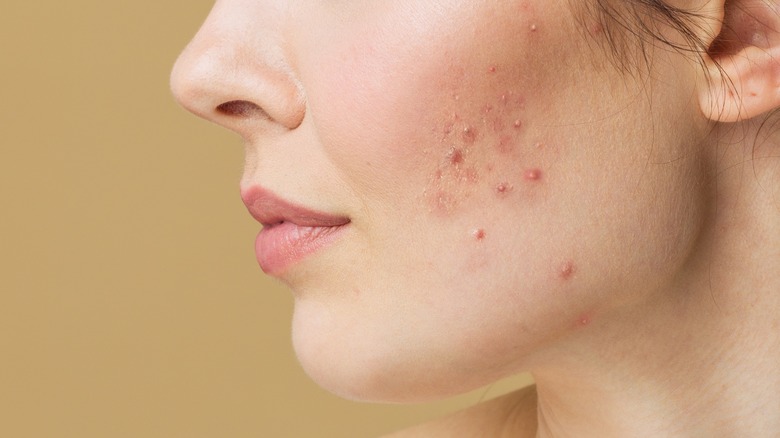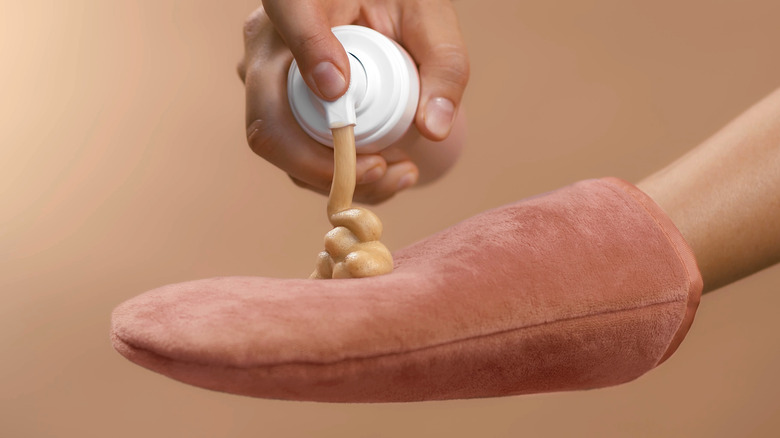How To Get A Flawless Self-Tan When You Have Acne-Prone Skin
Many people love tanning as a way to capture a healthy, sun-kissed glow, whether by soaking in the sun's UV rays or visiting tanning booths. "When I look in the mirror I feel more attractive when I'm darker, like my face is prettier," tanning bed enthusiast Lauren Kafka tells ABC News. "It's 100 percent a confidence boost for me." And according to research published in the Journal of Applied Social Psychology in 1992, those with medium-tanned skin tones were generally perceived as both healthier and more attractive.
That said, now most of us know that excessive tanning, either outdoor or indoor, goes hand-in-hand with skin cancer risks. It may feel good when you're tanning, but the sun damage will show later. The American Academy of Dermatology Association warns that using a tanning bed by the age of 20 can increase your risk of melanoma, the most deadly type of skin cancer, by 47%.
Due to the widespread campaigns about the negative effects of tanning, many people have given up this tempting beauty treatment. However, with the resurgence of self-tan, a technique of sunless tanning using tanning spray or tanning lotion, getting a bronzed look has become much safer and faster. Here's how you can recapture the summer glow on your skin in any weather using self-tan — even when you have acne-prone skin.
Acne vs. self-tan
The trick to a gorgeous self-tan is smooth application. But what if you're dealing with textured, acne-prone skin? And can self-tan products make your breakouts worse? According to British skin clinic sk:n, applying fake tan lotions and sprays won't make someone get acne in the long run. However, for those who already have acne-prone skin, using self-tanner can exacerbate their skin condition and cause a breakout by clogging pores, adding to oil buildup, and introducing unwelcome bacteria to their skin.
Echoing this sentiment, dermatologist Dr. Paul Jarrod Frank tells Skincare.com that certain self-tanners can give you an acne flare-up. "Some self-tanners contain preservatives and fragrances, which can cause the skin to break out," he says. So you may actually want to avoid self-tanner if you're having acne problems.
But if you're bound and determined to layer on some extra summer glow, here's how to do it. Take the time to prep your sensitive skin beforehand and give your self-tan the best canvas possible. To achieve desirable results, you must exfoliate your skin thoroughly first, says dermatologist Dr. Arielle Kauvar to the Skin Cancer Foundation. If there are parts of your skin that are thickened or callous, they will appear darker than the surrounding skin. Once your skin is smooth, it's all about application.
How to self-tan effectively at home
Freshly exfoliated and ready to self-tan? First, coat each section of your body with a thin layer of self-tanner. As celebrity tanner Jules Von Hep recommends to Harper's Bazaar, the general rule of thumb is to apply two coats on the body and one coat on the face. For an even look, apply the self-tanner in long, even strokes.
Once you're finished tanning, wait for about 15 minutes before getting dressed. To maintain the tan, try to wear loose clothes, avoid skin-to-skin contact, and refrain from physical activity for at least three hours after tanning. Sweating and smudging can cause the product to transfer and give your skin uneven brown streaks. Keep in mind that you should always give your body time to completely dry after tanning. According to tanning brand St. Tropez, the key to keeping your bronzed glow even and lasting for up to 10 days is to exfoliate every two or three days, as well as moisturize regularly.
If you go the spray tan route, wear a mask while tanning and don't spray tanner directly onto your face lest you inhale the product, dermatologist Chere Lucas Anthony tells Consumer Reports. "Studies have shown that cell damage is worse with repeated inhalation," she says. And even though many self-tanners contain mild sun protection, you should always follow a self-tanning session with a broad-spectrum sunscreen with an SPF of 30 or more to shield your skin from damaging UVA and UVB radiation.


